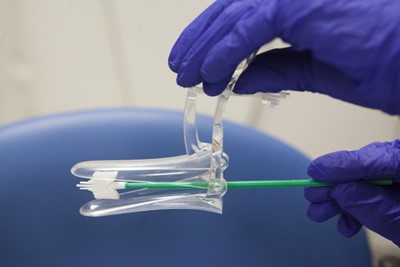FAQ - Cervical screening
We were sorry to see Jo’s Trust close. We valued their expert and patient centred information and have drawn on it here to help women in Liverpool make informed decisions on attending cervical screening.
What is cervical screening?
Cervical screening is a free health test available on the NHS as part of the national cervical screening programme. It helps prevent cervical cancer by checking for a virus called high-risk HPV and cervical cell changes. It is not a test for cancer.
It is your choice whether to go for cervical screening. We hope this information helps you make the best decision for you and your health.
This video produced by Cancer Research UK explains cervical screening
Is cervical screening the same as a smear test?
A smear test is the older name for the test. It was called that because of the way the test used to be done – cells were smeared on a glass slide, which was sent to the laboratory for testing.
The test is different now and most healthcare professionals call it cervical screening.
Who is invited for cervical screening?
You should be invited for cervical screening if you have a cervix. Women are usually born with a cervix. Trans men, non-binary and intersex people may also have one.
In the UK, you are automatically invited for cervical screening if you are:
- between the ages of 25 to 64
- registered as female with a GP surgery *
You may get your first invite up to 6 months before you turn 25. You can book an appointment as soon as you get the invite.
* Trans and non-binary people may wish to check with their GP surgery about how their gender is recorded in their records and which health screenings they should be invited to attend.
Why can’t I have cervical screening unless I am age 25 to 64?
It is very rare to develop cervical cancer under the age of 25. It is also rare to develop cervical cancer over the age of 64, if you have had regular cervical screening.
How often will I be invited for cervical screening?
How frequently you are invited for cervical screening is based on your last result and within a timeframe that is safe for you.
You may be invited:
- every year
- every 3 years
- every 5 years
- straight to colposcopy for more tests. www.nhs.uk/conditions/colposcopy/
What are the benefits and risks of cervical screening?
You are invited for cervical screening because evidence shows that the benefits of the test outweigh any risks. Along with the HPV vaccine, cervical screening is the best way to protect against cervical cancer and prevents over 7 in 10 diagnoses. However, like any screening test, cervical screening is not perfect and there are some risks.
What are the benefits of cervical screening?
- Cervical screening aims to identify whether you are at higher risk of developing cervical cell changes or cervical cancer. This means you can get any care or treatment you need early.
- NHS figures show fewer people in Liverpool attend their smear test than the average, with 62% going for one compared with 69% across the rest of England, which is one of the lowest rates in the North West. Within Liverpool there are also big inequalities in take up rates. This puts people in Liverpool at greater risk from cervical cancer.
Are there any possible risks of cervical screening?
- In a few cases, cervical screening will give an incorrect result. This means it may say someone does not have HPV or cell changes when they do (a false negative). Going for cervical screening when invited can help reduce this risk, as it is likely HPV or cell changes that were missed would be picked up by the next test. It also means a result may say someone does have HPV or cell changes when they don’t (a false positive), which could mean they are invited for tests or treatment they don’t need.
- Sometimes cell changes go back to normal without needing treatment. At the moment, we can’t tell which cell changes will go back to normal, so treating means we can be sure we are preventing them from developing into cervical cancer. This means some people may have unnecessary treatment, which is called overdiagnosis or overtreatment. Using HPV primary screening should help prevent this.
It is hard to know exactly how many people are affected by these risks. But we do know, for those aged 25 to 64, the benefits of cervical screening outweigh the risks, and most results will be clear.
If I don’t want cervical screening, how do I opt out?
If you decide you do not want to have cervical screening you can ask your GP to be taken off their invite list. If you change your mind, you can ask your GP to add you back to the list at any time. https://www.gov.uk/government/publications/opting-out-of-the-nhs-population-screening-programmes/opting-out-of-screening
What are the symptoms of cervical cancer and what should I do if I have symptoms?
If you have symptoms, contact your GP surgery about having an examination. Cervical screening is not for people who have symptoms. Cervical cancer may not cause any symptoms, or the symptoms may not be obvious. The most common symptoms of cervical cancer include:
- vaginal bleeding that is unusual for you, including after the menopause, after sex, or between regular periods
- changes to vaginal discharge
- pain or discomfort during sex
- unexplained pain in your lower back or between your hip bones (pelvis).
These symptoms usually happen for reasons other than cervical cancer. But it is also important to contact your GP straight away, so they can give you reassurance and support.
How do I book a cervical screening appointment?
If you are registered with a GP, you will get a letter telling you it is time for your cervical screening appointment. You have to contact your GP to book an appointment. You can usually do this online or over the phone.
In some areas, sexual health clinics offer cervical screening. You may choose to contact your local clinic if you aren’t able to access, or don’t feel comfortable at, your GP surgery.
Many GP surgeries offer cervical screening appointments on set days or at set times. If you can’t attend any of the available appointments, speak to your GP surgery to see if they can be flexible for you.
What might I want to think about before booking?
- It is best not to book a cervical screening when you have your period because it can make it harder to get a result.
- You should try not to use spermicide or oil-based lubricant (lube) for 24 hours before the test, as they can affect the results.
- Write down any questions you want to ask
What happens at the GP surgery?
Plan to spend at least 30 minutes at your GP surgery, which may include waiting for your appointment or being directed to the room. The test itself, where your nurse takes a sample of cells from your cervix, will only take a few minutes.
A nurse, sometimes called a sample taker, will invite you into a treatment room. They will explain what cervical screening is and check if you have any questions.
Your nurse will give you a private space to undress from the waist down, usually behind a curtain. If you are wearing a dress or skirt, you can leave this on and just take off your underwear.
This NHS page has a useful video/audio description of what is involved in having the screening done: https://www.nhs.uk/conditions/cervical-screening/what-happens/
Your nurse will ask you to lie on an examination bed and give you a new, clean paper sheet to cover the lower half of your body. You can lie:
- on your back with your legs bent up, your ankles together and your knees apart
- on your left side with your knees bent.
Your nurse will let you know when the test is about to start. First, they gently put a new, clean speculum into your vagina. A speculum is usually a plastic cylinder with a round end – sometimes a metal speculum is used. The speculum is the part that some people find uncomfortable.
Once the speculum is inside your vagina, the nurse will gently open it so they can see your cervix.
Then the nurse will use a small, soft brush to quickly take a sample of cells from your cervix. This may feel a bit strange, but should not be painful.
The nurse will put your sample of cells into a small plastic container (vial) of liquid. The liquid preserves the cells so they can be sent to a lab for testing.
And that’s it! The nurse will take the speculum out of your vagina and give you a private space to dress again. They will explain how and when you should get your results.
What does the equipment used look like?
A speculum and brush

What happens after a cervical screening appointment?
Most people can continue their day as usual after the appointment.
You may have some light bleeding (spotting) for a day after the test, so it can help to wear a sanitary pad or panty-liner.
Your cervical screening results should arrive by post within 4 weeks.
What can I do to make going for my cervical screening as easy as possible?
Talk to your nurse or doctor
If it is your first cervical screening, you feel embarrassed or worried, you have had a bad experience before, or you have experienced anything that makes the test hard for you, telling the person doing the test means they can try to give you the right support. If you don’t feel comfortable saying something, try writing it down.
Ask for the first appointment of the day
If you feel uncomfortable in waiting rooms, you may want to ask to book the first appointment of the day. This can mean it is quieter and there is less time for you to wait.
Ask to book a longer or double appointment
Having more time before, during or after cervical screening can help people take in information about the test and process everything that happens. If this would be useful for you, you may want to check if your GP surgery can offer you a longer appointment.
The receptionist may ask why you need a longer appointment – remember, you do not have to disclose anything.
Ask for a nurse or doctor of a particular gender
You may feel more comfortable knowing that a female or male nurse will be doing your cervical screening. If you have a nurse or doctor you trust, you may want to check with your GP surgery if they are able to do it.
Take someone you trust with you
If it would help or you need assistance, you can ask if someone can come with you. It could be a friend, family member, partner or someone else. They can be in the waiting room or examination room with you to offer support. They may also be able to speak on your behalf about any worries.
If a trusted person isn’t able to come to the appointment, you can check if another member of staff can be with you for support. This person is sometimes called a chaperone.
Wear a skirt or dress
If you feel comfortable wearing a skirt or dress, it may help you feel more covered. You can keep it on during the test and only take off your underwear.
You do get a paper sheet to cover yourself. If you would like to, you can also ask if you can bring a spare shawl or blanket too.
Ask for a smaller speculum
Speculums come in different sizes. If you find the standard size too uncomfortable, you can ask to try another size.
Put the speculum in yourself
You may feel more relaxed and comfortable about putting the speculum in your vagina yourself. If you have a partner with you, you may prefer them to put the speculum in.
Lie in a different position
Lying on your back may feel uncomfortable for lots of reasons. You can ask to lie on your left-hand side with your knees bent (left lateral position).
Use post-menopausal prescriptions
If you have gone through or are going through the menopause, let your doctor or nurse know. After menopause, the opening of the vagina and vaginal walls become less able to stretch, which can make the test more uncomfortable. You can ask your nurse to give (prescribe) you a vaginal oestrogen cream or pessary, which may help.
Ask to be referred to colposcopy
Sometimes the nurse may not be able to see your cervix. This could be because you have a tilted cervix, cervical stenosis (where the vagina narrows) or something else. It does not mean there is anything to worry about. The nurse may suggest you go to a colposcopy department for cervical screening, as they have equipment like adjustable beds that can help when trying to see the cervix.
For people who have experienced sexual trauma
If you have previously experienced sexual trauma you might be interested in our tips when attending health care appointments. This includes information on #checkwithmefirst cards that allow people to discreetly disclose that they may need additional support or more sensitive care.
What happens after a cervical screening appointment?
Most people can continue their day as usual after the appointment.
You may have some light bleeding (spotting) for a day after the test, so it can help to wear a sanitary pad or panty-liner.
Your cervical screening results should arrive by post within 4 weeks.
What might the results be?
No HPV found
- What it means: you don’t have high-risk HPV.
- Next steps - you will be invited for cervical screening in 3 or 5 years depending on your age.
HPV found – no cell changes found
- This would mean you have high-risk HPV, but you do not have changes to your cervical cells.
- Next steps - You would be invited for cervical screening in 1 year, to check the HPV is gone. If you get this result 3 times in a row, you will be invited to colposcopy for more tests
HPV found – cell changes found
- This would mean - You have high-risk HPV and cervical cell changes.
- Next steps - You would be invited to colposcopy for further tests.
Inadequate
- This would mean - the sample could not be tested properly, didn’t have enough cells or if the cells could not be seen properly under a microscope.
- Next steps - Repeat cervical screening after 3 months.
If I don’t want cervical screening, how do I opt out?
If you decide you do not want to have cervical screening you can ask your GP to be taken off their invite list. If you change your mind, you can ask your GP to add you back to the list at any time. https://www.gov.uk/government/publications/opting-out-of-the-nhs-population-screening-programmes/opting-out-of-screening
What are local services doing to improve cervical screening rates locally?
Central Liverpool Primary Care Network delivered a ‘Summer Smear Drop-In Clinic’. Three sessions a week including a Saturday across two locations to address the inequalities in take up. They have also been offering people being fitted with Long-acting contraception (LARC) a smear at the same time.
SWAGGA Primary Care Network, which covers a lot of South Liverpool has been running a Bits ‘n’ Bobs campaign to improve screening take-up. They have produced a range of videos to improve local awareness, have run extra sessions including on Saturdays and have been visiting communities with lower screening rates.

Can I screen at home?
At the moment you cannot do home screening for cervical cancer through the NHS. It is available privately. Because many people have told the Healthwatch network that they would prefer home screening Healthwatch England have called for this to be an option in future.
Our report on the impact of sexual trauma on attending NHS screenings and other appointments also includes a recommendation that: "if the current national work on self-screening for cervical cancer proves it to be an effective method, seek to roll this out locally as quickly as possible to allow those who would prefer to self-administer the test to have this choice."


